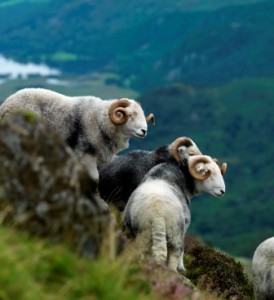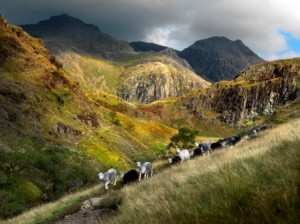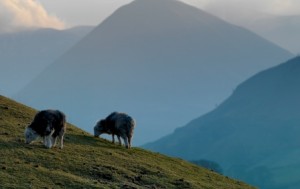Support us from £3/month
We deal with almost 1000 cases a year assisting communities, groups and individuals in protecting their local spaces and paths in all parts of England and Wales. Can you help us by joining as a member?
Andrew Humphries, experienced hill-farmer and teacher, writes about the contribution of the Lake District yeomen.
Unbounded freedom ruled the wandering scene
Nor fence of ownership crept in between
To hide the prospect of the following eye
Its only bondage was the circling sky.
(John Clare 1792-1864)
Writing when enclosure and ‘high farming’ were in full flow, Clare expressed the essence of pastoral commons as special places. Despite this, the largest area of unenclosed commons in western Europe exists today in the Lake District; why did this happen?
After the late eighteenth century, self-sufficiency in temperate foods gave way to increased imports; this stimulated large landowners to pursue a highly capitalised approach to agriculture and new techniques of husbandry.
In the Lake District, large landowners and aristocrats were few, though some enclosure of hill land did take place. At Grasmere Lady le Fleming’s agents in 1824 proposed to enclose the common. Wordsworth, who was devoted to the sublime landscape created by the farming practices of traditional yeomen, came to their aid and frustrated the process, so gaining him local approbation. As Hardwicke Rawnsley quotes in Reminiscences of Wordsworth among the peasantry of Westmorland (1968): ‘It was all along of him that Grasmere folks have their common open. Ye may ga now reet up t’sky ower Grisedale, wi’out liggin leg to t’fence, and all through him …’.
For the most part however the yeomen were in the driving seat through the prevalence of customary tenancies. Under these land could be bought and sold and passed to the next generation without the ‘will of the lord of the manor’.
One of the principal obligations on customary tenants was to provide military service in defence of the Border (known as Border Service).Following the union of England and Scotland, the crown and landlords challenged the continuing right of inheritance, but in 1625 a legal judgment secured the yeomen’s status as virtual freeholders.
Hill farming was essentially a low-input low-output system of agriculture. Walls and fences were expensive to build and maintain. Furthermore the annual cycle of sheep farming involved seasonal peak demands for labour including shearing and haymaking. Thus the yeoman was independent in spirit but communal in practice, leading to a customary system of land management that optimised the local labour force and was tailored to local circumstances.
On this basis the high commons remained relatively undisturbed. The heafed flocks of hardy Herdwick and other local breeds were acclimatised to their own areas of the fell. Shepherds and sheep alike were inseparable from their heafs, Wordsworth observing in The Prelude, Book VIII:
… that unfenced tract of mountain-ground,
Which to his Father’s little farm belong’d,
The home and ancient Birth-right of their flock.
Seasonal tasks were communally organised and the principle of ‘good neighbourhood’ prevailed. Large, often contiguous, commons remained to form a vital part of upland landscapes.
Key
A key to improving agricultural productivity in the lowlands was mechanisation to which much attention has been given by historians. By contrast, William Dickinson, a popular writer in the nineteenth century, wrote in The Farming of Cumberland (1852) that:
[T]he dog’s services are indispensable … he will sometimes do the work of twenty persons. … the dog is the last chattel the storms of life compel a feeling man to part with. … Without the dog the mountainous land … would not be worth sixpence. …
Wordsworth, in The Prelude, Book VIII, describes a shepherd who
Gave signal to his Dog, thus teaching him
To chace along the mazes of steep crags
The flock he could not see: and so the Brute
Dear Creature! with a Man’s intelligence
Advancing, or retreating on his steps.
Through every pervious strait, to the right or left,
Thridded away unbaffled. …
The case of cattle trespass by Johnby cattle on to the neighbouring Castle Sowerby common illustrates the localness and the value of custom to sustain respect and reciprocity.
…the Johnby cattle got into Castle Sowerby common and the Sowerby people impounded them, the person who went for the cattle carried no money but pledged his coat and had the said cattle returned,-some time after he carried money and had his coat returned.
(Extract from a witness statement to establish Common Boundaries between Greystoke and Skelton, DCC\1\160 Carlisle Record Office.)
This was not a ‘perfect republic’ (Wordsworth’s phrase) and there were elements of competition and conflict which were referred to manorial courts. As Eleanor Straughton notes in Common Grazing in the Northern English Uplands (2008), the courts’ disappearance during the nineteenth century left decision-making as an informal ad hoc process.
Grazing
Lakeland farmers are now working to establish contemporary governance that will sustain common grazings which are valued by hill farmers and walkers alike. High Nature Value farming, which is gathering momentum across Europe, offers the potential to support stewardship based on low-intensity farming and strong communal values. The Cumbrian commons, and all who appreciate them, would benefit from such support, but regrettably that shift in Common Agricultural Policy payments has yet to occur.
Photos by Ian Lawson.



